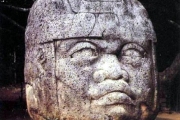Viewings: 7750

About three thousand years ago on the shore of the Gulf of Mexico appeared Indian culture, called the Olmec. This conditional name was given on behalf of the Olmec - a small group of Indian tribes living on this territory, much later, in the XI - XIV centuries. The name "Olmecs"means "rubber people", - Aztec origin. The Aztecs called them by name area on the Gulf coast, where they manufactured rubber and where they lived contemporary Olmecs. So in fact the Olmecs and Olmec culture is not one and the same. This circumstance is extremely difficult to understand for non-experts, type, Hancock, who devoted Olmeca in his book "Traces of gods" a lot of pages. Such publications are only compounding the problem, nothing at the same time, not explaining the merits of the case.
The civilization of ancient Olmec, the beginning of which goes back to the second Millennium BC, ceased to exist in the first years of our era and a half thousand years before the rise of the Aztec Empire. Olmec culture are sometimes called "the mother of cultures" in Central America and the civilization of Mexico.
Oddly enough, despite all the efforts of archaeologists, anywhere in Mexico, as in America, still could not find any traces the origin and evolution of the Olmec civilization, stages of its development, the place of its occurrence, as if this people has emerged as already put. Absolutely nothing is known about any social organization of the Olmec, or about their beliefs and rituals - in addition to human sacrifice. We do not know in any language I spoke Olmecs, the ethnic group they belonged to. And very high humidity in the Gulf of Mexico led to the fact that has no surviving skeleton of the Olmec.
Culture of ancient Olmec was the same "corn civilization"and other pre-Columbian culture of America. The main branches of the economy were agriculture and fisheries. To have survived the remains of religious buildings of this civilization - pyramids, platforms, statues. Ancient Olmecs cut blocks of stone and carved them massive sculpture. Some of them depict huge heads, today known as "the head of the Olmec". These stone heads - the biggest mystery of an ancient civilization...
Monumental sculpture weighing up to 30 tons portray the heads of people with no doubt Negroid features. It is almost portraits of Africans in tight-fitting helmets with strap on his chin. The earlobes pierced. The face is cut by deep wrinkles on both sides of the nose. The corners of thick lips curved down.
Despite the heyday of the Olmec culture falls on 1500-1000 years BC, confident that the heads were carved that in this era, no, because radiocarbon Dating of pieces of coal, found nearby, gives only the age of the embers. Perhaps the stone heads much younger.
The first stone head was discovered in the 1930-ies the American archaeologist Matthew Stirling. He wrote in his report: ' Head was carved from a single massive basalt boulders. It rested on a Foundation of unprocessed stone blocks. Being cleared from the ground, her head had quite scary. In spite of considerable size, it is treated very carefully and steadily, its proportions are perfect. Unique among the sculptures aboriginal America, it is notable for its realism. Her features distinct and clearly Negro type".
By the way, Stirling had made another discovery - he found a baby toy dog on wheels. This innocent, at first glance, Nakhodka actually was a sensation because it was believed that civilization pre-Columbian America wheel did not know. But, it appears, on the ancient Olmec this rule does not apply...
However, soon it turned out that Maya Indians, South contemporaries of the ancient Olmec did toys on wheels, but the wheel in your business practices are not applied. A great mystery here there are the roots of such ignorance wheel is rooted in the mentality of the Indians and "corn economy". In this regard, the ancient Olmecs were little different from other Indian civilizations.
In addition goals, ancient Olmecs left numerous examples of monumental sculpture. All of them are carved from basalt monoliths or other solid rock. On Olmec stelae you can see the scenes of the meeting of two distinctly different human races. One of them Africans. And in one of the Indian pyramids are located near the Mexican city of Oaxaca, located a few stone stelae carved with scenes of capture Indians bearded white men... and Africans.
Olmec heads and images on the stelae are physiologically accurate images of the real representatives of the Negroid race, whose presence in Central America 3000 years ago is still a mystery. How could appear Africans in the New World before Columbus? Maybe they were the aboriginal inhabitants of America? There is the testimony of paleo-anthropologists that as part of one of migrations on the territory of the American continent during the last ice age really got blacks. This migration was about 1500 BC
There is another assumption is that in ancient times between Africa and America was carried out contacts across the ocean, which, as it turned out in the last decades, not shared ancient civilizations. The assertion about the isolation of the New world from the rest of the world, has long prevailed in science, it has been convincingly refuted Round by Thor Heyerdahl and Tim Severin, who proved that contacts Old and New world could be long before Columbus.
The Olmec civilization ceased to exist in the last century BC. But their culture is not lost - it is organically entered in the culture of the Aztecs and Mayans. And Olmecs? In fact, the only "card", which they had left behind, is a giant stone heads. Head of Africans...
















